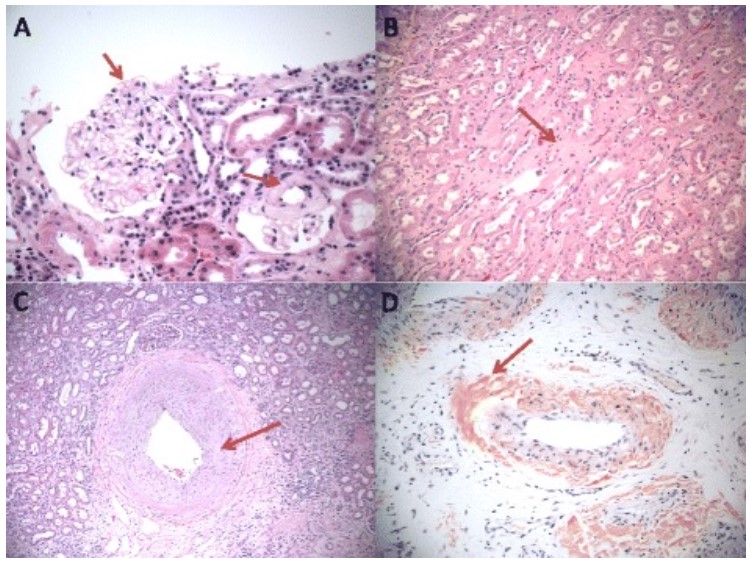Playlist
Show Playlist
Hide Playlist
Nephrotic Syndrome: Pathophysiology with Case
-
Slides Nephrotic Syndromes.pdf
-
Reference List Nephrology.pdf
-
Download Lecture Overview
00:01
Hello and welcome back.
00:03
Today in our
nephrology curriculum,
we're going to be talking
about nephrotic syndrome,
which are part of the
glomerular diseases
and one of my
personal favorites.
00:11
Let's start out with
a clinical case.
00:13
We have a 45 year old gentleman
who presents to the
hospital with weight gain
and worsening lower extremity
edema over the past two months.
00:21
His laboratories are significant
for a serum creatinine of 1
.2 milligrams per deciliter.
00:26
His the albumin in the serum is
low at 2 grams per deciliter.
00:31
His urine analysis shows four
plus protein on the dipstick,
but there are no white cells
are red cells by microscopy
and he has about
8 grams of protein
estimated on a urinary spot
protein to creatinine ratio.
00:44
So the question is,
is this nephritic or is
this nephrotic syndrome?
Let's look through
our case and see
if we can arrive
at that diagnosis.
00:54
So what we can see is that our patient
had worsening lower extremity edema,
and this is because
of that low albumin
or a hypoalbuminemia.
01:01
Why does he have a low albumin?
Because he's spilling a
lot of protein in his urine
we have 8 grams of
protein in the urine.
01:08
That's a large quantity.
01:10
He has a normal serum
creatinine relatively
and he has no
red blood cells or no white
blood cells in his urine.
01:17
So taken together,
this really is more indicative
of nephrotic syndrome
and something to really
help us think about
is that nephrotic
contains the letter O
and podcyte which
is the superstar
of nephrotic syndrome
has the letter O in it.
01:34
When we think about nephritic,
it has an I on it.
01:37
When we think about
nephritic diseases,
they're more inflammatory.
01:41
So I think that can
help us distinguish
between nephrotic and
nephritic syndrome.
01:45
So of course in our answer,
this is nephrotic syndrome.
01:50
So let's talk a little bit about
what nephrotic syndrome is.
01:53
It's actually characterized
by the clinical presentation
of four different things.
01:58
Number 1.
01:59
Our patients have to have
nephrotic range proteinuria.
02:02
That means they have
greater than 3.5 grams
of protein in their urine
over a 24-hour period of time.
02:09
Our patients also manifest
with hypoalbuminemia
in this serum.
02:14
Those serums albumin levels are
less than 3 grams per deciliter.
02:17
Remember normal is four
grams per deciliter.
02:20
Sometimes with certain
of radek syndromes,
we can see even a 0.8
grams per deciliter.
02:26
The serum albumin is so low.
02:28
Our patients also have edema
as shown here in our
schematic in the diagram.
02:33
We've got pitting edema
as our patient is actually
so volume overloaded
because of that sodium
and water retention due to
their nephrotic syndrome.
02:42
And of course,
we have hyperlipidemia and lipidurea.
02:47
So let's talk about these
a little bit more closely
so we can better understand
the pathophysiology
of nephrotic syndrome.
02:53
So proteinurea,
we talked about high-grade proteinuria
greater than 3.5 grams.
02:58
We know that this is
glomerular proteinurea
because the principal component
is going to be albumin.
03:03
So what exactly does that mean?
Patients who have nephrotic
syndrome will have an increase
in filtration of macromolecules
across the glomerular
capillary wall
because of abnormalities in the
glomerular epithelial cells to podocytes.
03:16
As I mentioned albumin is
kind of the star player here.
03:19
It's the principle protein
that makes up that
urinary protein
and that's what's lost in
glomerular proteinuria.
03:25
We can lose other things like
clotting inhibitors, transferrin,
and vitamin D binding
protein as well.
03:31
But we really think about our
patients as losing a lot of albumin.
03:34
Now, if you look at our
schematic over here,
we actually have the
glomerular capillary wall.
03:39
So to the right of the slide
we have that capillary lumen.
03:42
The red cells are the endothelial
cells that are lining that lumen,
the yellow is the
glomerular basement membrane
and then those little picket
fences or those little fingers
that are standing up are our
podocytes foot processes.
03:55
And those are
incredibly important
because their job as they
interdigitate together.
04:00
They form these
elegant slit diaphragms
and that job is to keep
all of the good stuff
those macromolecules like
albumin and clotting inhibitors
and vitamin D binding
protein in the serum
and let the filtrate go through.
04:13
When we have problems with
glomerular proteinuria,
there's something wrong
with the integrity
of those podocytes in
those slit diaphragm
so they can't interdigitate
the way they should
and then therefore we have
escaped of macromolecules
into the urinary space.
04:28
So we mentioned that our
patients have hypoalbuminemia,
and that's simply due
to the consequent loss
of albumin in the urine.
04:35
Our liver tries it's best
to synthesize as much
protein as possible.
04:39
So we have hepatic
albumin synthesis,
but it's not able to keep up
to replete those serum levels
sometimes our patients can manifest
with 45 grams of proteinuria.
04:48
So you can imagine how hard the
liver is working to try and to
sufficiently replete
the serum levels
and sometimes that
just can't happen.
04:55
And then often times our
patient's albumin levels
will drop to less than
2 grams per deciliter.
05:01
We also mentioned edema,
and this is consequent
to the hypoalbuminemia
that causes egress so fluid
into the interstitial space
because we have a decrease
in plasma oncotic pressure.
05:11
We don't have album
in there to hold on
to that vascular fluid
into the vascular space.
05:16
We also get stimulation of
the renin-angiotensin system.
05:20
So in the end,
we end up with aldosterone release
causing marked sodium retention
that's working at
that principle cell.
05:26
We have sympathetic stimulation
to increase sodium retention
and we also have reduce to
natriuretic peptide release.
05:33
All of us together
causes that soft pitting
dependent edema that
we see in our patients.
05:40
Finally, we have hyperlipidemia.
05:43
Remember that decreasing
oncotic pressure
is also going to stimulate
hepatic lipoprotein synthesis.
05:48
So the liver will be
producing a lot of lipid
that's going to manifest
as hypercholesterolemia
or hypertriglyceridemia.
05:58
We can also see lipiduria.
06:00
That's when lipid actually
becomes in trapped in the urine
in the cellular casts or in cass
so you can see that also
in the plasma membrane
of a degenerated
tubular epithelial cell.
06:11
So as we have a lot of
lipid, remember,
in protein those proximal
tubular epithelial cells
are trying to absorb
as much as possible
and sometimes they detach
from the underlying
basement membrane
to become engorged with lipid
and they turn into
these ol fat bodies
that you can see right
here in our slide.
06:26
So it almost has a little
bit of a brownish hue
with his refractory elements.
06:30
Those are lipid oval fat bodies.
06:32
Now, if you're lucky enough to have
a polarizer on your microscope,
these guys can actually turn
or show multis crosses where that
where those lipid elements are.
06:43
There actually fun to look at underneath
the urine underneath a microscope.
About the Lecture
The lecture Nephrotic Syndrome: Pathophysiology with Case by Amy Sussman, MD is from the course Nephrotic Syndrome.
Included Quiz Questions
Which of the following is associated with nephrotic syndrome?
- Hypoalbuminemia
- Proteinuria of <2.5 g/24 hours
- Inhibition of the renin-angiotensin system
- Hematuria with RBC casts
Which of the following is involved in the pathogenesis of hyperlipidemia in nephrotic syndrome?
- Increased hepatic lipoprotein synthesis
- Decreased renal excretion of lipoprotein
- Increased activity of lipoprotein lipase
- Laboratory error because of hypoalbuminemia
Which of the following statements is correct?
- Glomerular proteinuria leads to the loss of clotting inhibitors.
- Nephrotic syndrome is the result of inflammation affecting the glomeruli.
- The edema in nephrotic syndrome is mainly due to increased hydrostatic pressure.
- Nephrotic syndrome is characterized by sodium and water depletion.
Customer reviews
5,0 of 5 stars
| 5 Stars |
|
5 |
| 4 Stars |
|
0 |
| 3 Stars |
|
0 |
| 2 Stars |
|
0 |
| 1 Star |
|
0 |




